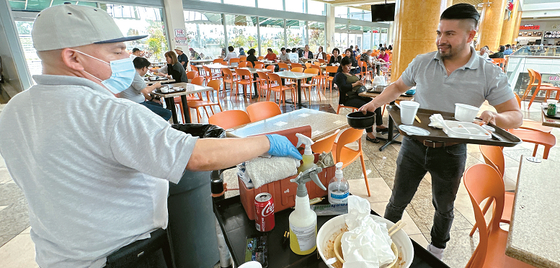
Restaurants in LA Koreatown have emerged as a significant driver of job creation in the city. Yet, most restaurant workers earn low wages and grapple with the high costs of housing, a new study reveals.
On October 24, the UCLA Labor Center published a report concerning restaurant workers in Koreatown. The report highlighted that Koreatown has been both a workplace and residence for multiracial immigrants for over 40 years since its establishment in Los Angeles.
The study found that 704 restaurants are currently operating in Koreatown, spanning roughly two square miles. These establishments employ 9,695 individuals. Including workers from other sectors, the total workforce in the area amounts to 59,437.
While the restaurants in Koreatown comprise just 3% of the 18,708 total restaurants in LA County, a significant 60% of them are small, family-run businesses. This implies that they possess greater job-creating potential compared to large franchise restaurants found in mainstream society.
Notably, 77% of restaurant workers in Koreatown hold full-time positions, surpassing the full-time employment rate of LA County overall (54%).
Breaking down by employee size: 421 Koreatown restaurants, or over half, employ fewer than 10 individuals. 145 restaurants (20% of the total) have between 10 and 19 employees. 109 establishments (15.5%) staff between 20 and 49 people, while 28 are larger restaurants with 50 or more employees, averaging 74.5 employees each.
Of these workers, 74% are immigrants. Mexicans constitute 51%, followed by Guatemalans (15%), El Salvadorans (13%), and South Koreans (11%).
“Koreatown is not only a hub for dining but also a vibrant nightlife and tourist destination. In recent times, both the City of Los Angeles and various civic and business leaders have reaped benefits from its rising popularity, evident from the surge in luxury housing, hotels, and the influx of urban professionals,” commented Saba Waheed, the report’s author.
Sector-wise, restaurants and bars make up 15% of all businesses in Koreatown. They’re succeeded by retail (12%), health care and social assistance (8%), professional, scientific, and technical services (7%), construction (7%), administrative support, waste management, and remediation services (7%), and personal and repair services (7%).
The study also highlighted a concerning trend: almost half (46%) of restaurant employees are burdened by soaring housing costs. Moreover, 72% of them in Koreatown are undercompensated. This figure is slightly higher than the 70% observed for LA County’s restaurant workers.
Wages showed variation across roles. Data from 2017-2021 indicates that servers in Koreatown earn an average of $14.86 per hour, marginally higher than the $14.30 hourly rate in LA County. Conversely, chefs in Koreatown earn about $13 per hour, which is $1.99 less than their counterparts in LA County, who make $14.99.
The UCLA Labor Center collaborated with the Koreatown Immigrant Workers Alliance (KIWA) and San Diego State University to produce this report.
BY NICOLE CHANG, JUNHAN PARK [chang.nicole@koreadaily.com]




